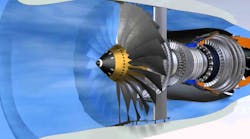The U.S. Federal Aviation Administration ordered additional inspections of fan blades in CFM56-7B engines, continuing to determine the full extent of the maintenance problem that led to a deadly explosion aboard a Southwest Airlines 737 on April 17. A round of inspections that FAA ordered in the immediate aftermath of the incident are still underway.
FAA has attributed the explosion to a broken fan blade that destroyed the engine and its cowling, causing debris to break a window. A passenger was drawn from her seat next to the window by the force of cabin depressurization, and later died from the resulting injuries.
The fan-blade failure is assumed to have been caused by “metal fatigue,” meaning the material’s structural integrity is degraded as a result of repeated use.
The earlier FAA order required all U.S. airlines to complete ultrasonic and eddy-current inspections of fan blades on all CFM56-7B engines on Boeing 737 Next Generation aircraft with at least 30,000 engine-cycles by May 10. The European Aviation Safety Agency issued a similar order. An estimated 681 of the engines are in service worldwide, according to published sources.
Each engine cycle consists of an engine start, takeoff and landing, and full shut down.
Now, the FAA is ordering CFM56-7B engines with 20,000 engine cycles to be inspected by August 31.
According to CFM International, the joint venture of GE Aviation and Safran Aircraft Engines that manufacturers the CFM56-7B, the new order adopts the inspections standard recommended in an April 20 service bulletin issued by the manufacturer and adopted by FAA and EASA.
Immediately after the incident, CFM assigned several dozen technicians from GE Aviation and Safran Aircraft Engines to assist Southwest Airlines’ accelerated inspection efforts.
A Southwest Airlines spokeswoman has said the airline would complete ultrasonic inspections on all fan blades on all of its aircraft (about 700 in total) with CFM56-7B engines by the FAA’s initial, May 10 deadline.







